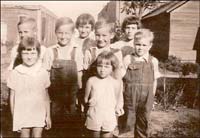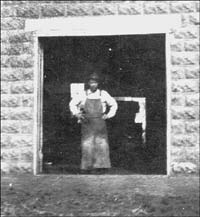
|
|
|
Search our site
Check these out    Do you have an entertaining or useful blog or personal website? If you'd like to see it listed here, send the URL to leon@pawneerock.org. AnnouncementsGive us your Pawnee Rock news, and we'll spread the word. |
Too Long in the WindWarning: The following contains opinions and ideas. Some memories may be accurate. -- Leon Unruh. Send comments to Leon February 2008The thousand-dollar acre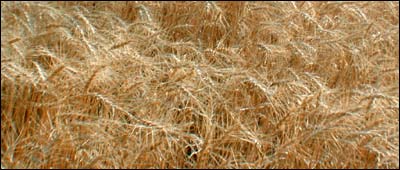
[February 29] I'm sure I'm not the first person to mention that the March futures price of wheat hit $25 in Minneapolis this past week. Forty bushels an acre times $25 is a lot of airplanes and new combines for farmers who haven't sold last summer's wheat yet. I remember the golden days of the early and mid-1970s when wheat hit $5 and the farmers hit the stores. Everybody was happy -- about the wheat price. Those months may seem familiar. Our Saudi friends had jacked up the price of oil, inflation was getting worse, an unpopular war was staggering along, and a secretive Republican administration was living out its last months in the White House. Sure, the price of wheat has settled to about $18 now. Even so, any farmer with a full granary probably is going to be able to pay off loans and overplant next fall, but I suspect that the real profits will be held by speculators and middlemen. In 1975, when I was a cub reporter for the Larned Tiller and Toiler, editor Jack Zygmond sent me to Hutchinson to get the scoop on prices at the Dillon's bakery. It seems that the bakery was turning a nickel's worth of wheat into a loaf that cost about a dollar, and Jack was determined to have me get a quote from somebody at Dillon's saying, "Sure, we shaft the farmer and we shaft the consumer." It didn't quite work out that way, despite Jack's badgering me into three long-distance calls to do just that. But I did learn a lot about baking bread on my tour, and I was surprised how much work and investment goes into each loaf and the machines and people that make it. Now the good farmers and shopkeepers of Barton, Pawnee, Stafford, and Rush counties will be praying for a spring of rain and a summer without hail. Good luck, and I hope everyone makes a lot of bread. Hello, Dean McFann[February 29] Dean McFann, who went to Pawnee Rock schools from first grade through his junior year (when the high school was closed), now lives in Scott City. He has joined our Friends of Pawnee Rock page. You make remember Dean from the basketball team here and at Macksville High. His grandparents, Cal and Elsie Rogers, ran the gas station along the highway. Dean's sister, Marsha, sent us a family photo a few months ago. Happy Birthday! The statisticians say that 1 out of every 1,461 Americans was born on Leap Day. Jeff Deeter, my musher[February 28] Jeff Deeter is 19 years old and Sunday he's going to stand behind his sled at the starting line of the Iditarod Trail Sled Dog Race and tell 16 straining, happy huskies to take off for Nome. What did I do when I was 19? I drove four hours from Pawnee Rock to college and was proud of myself for reaching a distant metropolis via state and federal highways.
What did I do at 19? I played basketball for as long as the cold ball would bounce. Jeff will feed and water his huskies several times a day. He'll bed them down in straw he spreads on ground that has been snow-covered since September. With his ax, he'll be able to get water from under the ice on a river or lake. What did I do at 19? I camped out on snowless nights along the Arkansas River. Jeff will drive his huskies -- if his sled doesn't break on an icy gulch and if a blizzard doesn't strand him -- 1,100 miles to a gold rush city. He'll do it in about two weeks. Jeff is doing this and then he'll get ready for college next fall in Fairbanks. What did I do at 19? I read about people who lived in the icy north, and I daydreamed of snowshoes and wolves. So when Jeff, who I met last year when I was building a website for another musher, Frank Sihler, asked me to do the same for him this year, I jumped at the chance to create JeffDeeter.com. Jeff is a quiet guy and very smart. His dogs love him. He lives in a broken-down trailer at Frank's place so he can be close to the dogs and training trails. What do I do now? Besides standing on a lake and cheering for my musher as he heads to the Bering Sea, I listen and learn, and I plan my own adventures, more ambitious than the ones I had at 19. How to find those old towns[February 27] Arlyn Smith of Wichita got a kick out of the 1886 map of Barton County that was posted yesterday. To help us all see what the settlements look like today, he suggests using a variety of online maps that we don't hear of as often as Google Maps. I followed his directions, and I agree -- Microsoft beats Google six ways from Sunday when it comes to higher-resolution images of our part of the state. Here's what Arlyn (the great-grandson of Lucy Houdyshell) wrote Tuesday: "I particularly enjoyed the old map you published today (2/26) and want to make sure you know about a terrific resource that I have had a lot of fun with. "While most of the world was getting excited about Google Earth another product was more quietly moving right along and, for rural areas, outperforms Google by miles. The site is maps.live.com. Google doesn't provide much detail in rural areas but maps.live.com is pretty complete. "For example if you go to maps.live.com and search for Dubuque, KS, the product will take you right to a map with the old town site of Dubuque marked. "If you fool with the software a little you can do amazing things like display only line maps, aerial photos, or overlay both. You can zoom in as close as a 150 yard-above-ground view or far enough out to see the whole US. "Using Dubuque as an example (as you did in your story), you will see that where the software puts the point doesn't look exactly right -- but if you look at the map you published it appears the town was nearer the county line. Back on the maps site you can see there is a farm on that road right at the county line but a disturbed part of the field right south of that farm and north of the map pointer that could be the right spot. "Anyway, it is fun to fool with -- now to get time (and permission from whoever) to get over there someday with a metal detector. "You can use the software to find all your old haunts in PR much like I do with my old haunts north of Larned and Rozel." A day for Kansas geography: My sister, Cheryl, published a neato column about Kansas place names Tuesday in the Emporia Gazette. It's just a coincidence that we both looked at maps on the same day. You could read her column in the Gazette, but the version on her Flyoverpeople.net site is illustrated. Towns that are and aren't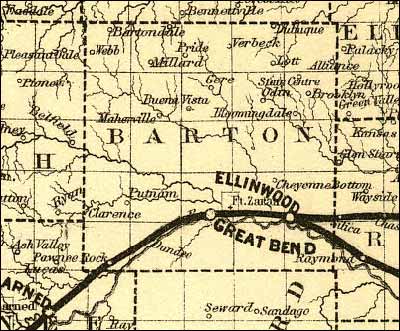
[February 26] This is a map of Barton County in 1886, found on the state's Skyways library site. What struck me first about the map is the absence of so many towns we know and the presence of so many places where big dreams dried up. Great Bend, Ellinwood, Dundee, and of course Pawnee Rock still exist, because these towns are all railroad towns along a federal highway. Millard survives along a spur line, and Dubuque and Odin also hang on, at least as spots on the map. I am sad to say that I can't remember ever visiting Dubuque. Here's a roll of the towns, settlements, and clusters of homes that once were: Alliance, Bartonville, Bloomingdale, Brooklyn, Buena Vista, Cheyenne Bottom, Clarence, Gere, Lott, Maherville, Odin, Pride, Putnam, State Centre, Verbeck, and Webb. Which towns were born after the 1886 map was drawn? Beaver, Boyd, Claflin, Dartmouth, Dent, Farhman Station, Galatia, Heizer, Hitschmann, Hoisington, Kanbrick, Olmitz, Redwing, South Hoisington, Susank, and Stickney. Incidentally, the map shows that our neighbor to the southeast, Radium, wasn't there in 1886, but Ray (which isn't anymore) was. Also, State Centre was close to Kansas Centre (Rice County), but neither is truly close to the center of Kansas, which is closer to Dent, northwest of Cheyenne Bottoms. So, if anybody tells you that rural Kansas towns are drying up and blowing away, look 'em in the eye and say: "We've always done it that way." Newton Smith: blacksmith and law officer
Threshing outfit of Newton Smith, taken in the early 1880s. Presumably, that is Mr. Smith standing on a wagon next to the steam-powered engine. [February 25] Early Pawnee Rock must have had quite a few tough people -- new arrivals willing to bet their lives on a piece of the windy plains along a railroad track between Topeka and Santa Fe. Fortunately for those who liked law and order, among those tough guys was Newton Phillip Smith. He was a blacksmith and a gangbusting constable and marshal who married a local girl and became the father of a contractor who apparently built many of Pawnee Rock's finer buildings. Here is a profile of Mr. Smith, taken from the 1912 "Biographical History of Barton County, Kansas." Newton Phillip SmithNewton Phillip Smith was born September 7, 1856, in Woodford County, Kentucky. He remained in his native state until he was fifteen years of age at which time he came to Barton County. This was in 1872 and he saw the county grow from an abode of buffalo and Indians to its present high state of cultivation. After he had been here a few years he pre-empted a claim of 80 acres in section 10, Pawnee Rock township and also the same amount Of land in section 25 of the same township. He ran a threshing machine and farmed for a number of years and in 1S90 established a blacksmithing and repairing shop in Pawnee Rock. This is the pioneer shop of that section of the county and the work that is turned out there is known all over the county as the best that can be obtained. It was while he was constable, an office that he held for several years that he broke up the Taylor gang of outlaws and horse thieves. This gang, led by George Taylor, terrorized this section of the country for a long time until Mr. Smith took up their trail, and finally located them south of Fort Supply [northwestern Oklahoma, or Indian Territory] where he rounded up the gang and recovered a number of horses belonging near Pawnee Rock. This was one of the most desperate gangs that ever infested this part of the state and before they were captured it was necessary to kill their leader. For this excellent work Mr. Smith received many words of praise and the heartfelt thanks of the entire community. He also served as city marshal of Pawnee Rock an office in which he made a most enviable record. He was married in 1878 to Miss Mary Jane Lile and they are the parents of four children: Edwin G., 33 years of age, a contractor and builder who has built some of the finest buildings in Pawnee Rock among them being the school building and all the good buildings in the town; Garfield, 32 years of age, aids his father in the blacksmith shop and is a skilled workman; Earl, 25 years of age, is manager of the Rock Mill and Elevator Company's interests in Great Bend; Elaine, 28 years of age, is a clerk in one of the biggest stores in Pawnee Rock. Mr. Smith has always been an enterprising and progressive citizen and is one of the really old timers of this section of the state and has had no small part in making of Barton County one of the best in the State of Kansas.
Newton Smith's grave is in the northwest part of the center section of the Pawnee Rock Township Cemetery. This view looks east from the road. Tracks in the snow[February 24] I get pleasure in being the first to put a footprint somewhere. That is a guilty pleasure on a snowy day, because being the first means that I have blemished the view for everyone else. Take a snowy yard, say, just after Saturday's snowstorm in Pawnee Rock. The first person to cross the yard enjoys but ruins the picture-postcard view, although sometimes you just have to walk out to the car no matter how pretty the scene is. As you or I stomp or shuffle across that expanse, we amuse ourselves as we please. We can even make a snow angel if we don't mind the risk that the lady next door is likely to call an ambulance after seeing us unexpectedly lie down and thrash about. The next person to walk to the car can do those things, too, although it won't be in a perfect setting. The fact of a snowy yard remains, but just by being there we have changed the essence. One of my great winter joys as a child in Pawnee Rock was breaking ice, the sheet that forms over a puddle and sounds hollow when you tap it. Melted snow that refreezes makes the best ice, and in Kansas, with its wide temperature swings over cold ground, we could count on that happening just about every winter day when there was moisture at our feet. Obviously, putting my foot through the ice meant that no one else could have the same pleasure until the water went through its cycle again. For a day, I could look at the shards and know that I had been there, done that, made my mark on the world. Even now that I'm mostly an adult, I'll walk across the street to break a sheet of ice. I don't care if it makes a crack so loud the neighbors wake up. Two nights ago, as I walked the dog, I found a glorious sheet. It must have been a dozen feet long and four feet wide, and it resonated like a guitar when I kicked a clod of crusty snow across it. Fool that I am, I left it as I found it. Yesterday morning I took our 11-year-old, Sam, out on the pretense that he would help me walk Buddy. It was a day meant to be remembered -- blue sky, 20 or so degrees, no wind; it was the kind of morning when the sounds you make will echo through the rest of your life. I gave Sam the sheet of ice. This is his childhood too. A photo I like: No. 75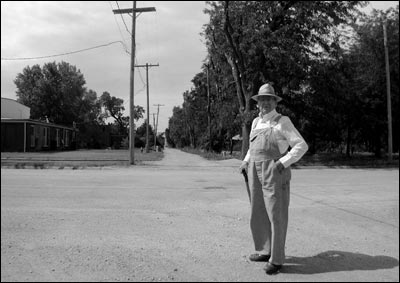
[February 23] This photo has a lot of memories. They're not so much related to my dad, who is standing in the middle of it, but more to what is around him. He's on the edge of Santa Fe Avenue where the alley crosses it just east of the old fire station. The street itself used to be like any other in town until the year the state paved it and ran a U.S. 56 detour on it. Across the street are the rear of the Christian Church and the alley, which continues south to downtown and eventually the highway. On a pole along the alley once perched the twin-eyed monster that flashed its lights when the fire siren went off, and the trees survive from a nursery that for all my childhood was a mysterious forest. The mulberry tree under which firefighters and city workers parked and from which I plucked much fruit was removed, it seems, during the detour days. Over all of this is the beautiful sky, across which the wind and clouds fly and from which the sun and rain beat down. On this day, the sky was low, but still I feel the openness of a town on the plains. It was in this scene also that on one autumn morning, as Dad walked on the wrong side of the street, he was struck a glancing but injurious blow by a pickup whose driver was blinded by the sun. After the accident, as Dad's life inched back toward normal, I struggled to understand how he could endure walking past that spot on his way to the post office. But he did, as he had for forty years and as he would do until he and Betty moved to Great Bend. About those broken trees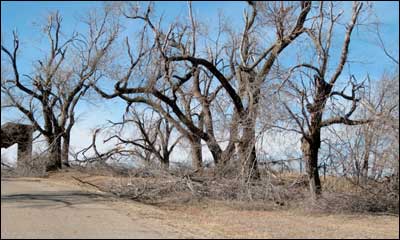
This photo, made on Pawnee Rock by Larry Mix in February 2008, shows limbs broken by the December 2007 ice storm. [February 22] Last week I wrote to our friends at the Kansas Historical Society -- the organization that runs Pawnee Rock State Park -- to ask about the still-to-come cleanup of broken limbs on the Rock. (Background here and here) Not knowing much about how maintenance of the Rock is conducted, I asked three questions:
Yesterday's in-box contained a pleasant note from Julie (Pope?) of the Society: Thank you for your e-mail. This has been a tough Winter for most of our historic sites. Some of them still have limbs that need to be removed. While we want our historic sites to look their best, it has been difficult to get these limbs removed due to our mixed weather in Kansas this year. We are presently working with an individual in the community who helps us take care of Pawnee Rock. We will contact him again to see when he will be able to complete the task. To answer your questions: 1) The Kansas Historical Society (State of Kansas) does pay for the
maintenance of the park. Thank you for your concern about Pawnee Rock. If I can be of further assistance, please let me know. Sincerely, Country boy, city boy: Ray Randolph, now of Indiana but once a Barton County farmboy, responded to yesterday's posting about Virgil Smith's photo of greenery along a gravel road. "Only those of us who have had the displeasure of riding the old bikes with balloon tires through patches of stickers (sand burrs) can appreciate the frustration of a bicycle in the country. "After we moved from the farm to Hoisington, it was such a kick riding on the streets without fear of flat tires." Roadside greenery
I imagine that a lot of kids who rode bikes in the country know those plants. They grow fervently in disturbed soil, even road dirt pushed into a berm by the grader in the spring. The berm holds last year's weed seeds and this year's water, and it makes a perfect long garden. The thorns become treacherous later in the summer, long after the golden blush has left the wheat stubble. They make more trouble for anybody riding in the soft gravel at the edge of the road instead of on the hard-packed and relatively gravel-free middle. But there are a few weeks when the sticker plants are simply pretty, a lush green in a ripening world, a shelter for hawk-wary field mice, and no threat at all to an innertube. A distant point of reference[February 20] One of the bits of knowledge we accumulated from our parents is the location of Radium. We get this while standing on the pavilion on the Rock and, pressing our young hands around the iron pipe for safety as we rise on our toes, we look southeast along our parent's arm until we see a speck of white.
That oddity is what makes sightseeing from the Rock special. Standing on the pavilion's flat roof gives us the ability to see over the clutter of the trees and houses as far as the horizon. We can go up anytime to reassure ourselves of the continued existence of Larned, Dundee, Great Bend, and Seward. Lovely and small Seward, five miles beyond Radium but still a glint on days when the haze is gone. It is the most distant recognizable point. You can't see those towns from the highway in Pawnee Rock, but we know they are there, just over the horizon, just beyond the creek and the river and the farms. The map, the bigger view, is in our wiring. I think no one from other towns really understands our perspective. We may not give it much thought either; the view is something we were born with. Those other towns are on bottom land, with a flat view, although part of Larned does rise north of the river. Still, people in Larned never spoke to me of the view from their hill; maybe they never noticed it, which could be the price they pay for living in a county seat, where the view sometimes stops at the edge of town. Barton County's only interesting point[February 19] Back in 1882, when Barton County was a whole decade old, someone had the great idea of writing up the county's history. After a suitable time for writing and printing, the world was given "Early History of Barton County Kansas 1883." I don't know who published the book, but it may have been one of the newspapers in Great Bend. None of them in business then still exists. The county's population was spread out much more evenly in those days. Pawnee Rock Township had 493 people, according to the 1880 census. Great Bend Township, including the county seat, had 1,648 residents. Liberty Township, east of Pawnee Rock, had 360, and Clarence Township, north of Pawnee Rock, had 489. Tucked into the narrative is a paragraph about our hometown's landmark. I've broken it up to make it easier to read. At the end of the book, a paragraph describes the town. "Pawnee Rock"One of the points of interest in the county, and about the only one to which any particular interest attaches, is a rock in the southwest corner of the county, known as "Pawnee Rock." There is also a village of this name in the same locality. It is the rock, however, that is the interesting point. The rock is at the southern terminus of a ridge, or bluff, that extends for several miles in a northeasterly direction north of the Arkansas River. It is, or was, about 100 feet high, but lately several feed [sic] of rock have been taken from the top of it. The top is almost perfectly flat, and is about 240 feet in circumference. In former days it was a great landmark for travelers, and many are the names inscribed on its face, and among them that of R. E. Lee, and under it the year 1845. Some of the names it bears are followed by dates much older than that following the name of R. E. Lee. The rock derives its name from the fact that the various tribes of Pawnee, when they desired to hold a general council, would meet on the top of it, and hence the name "Pawnee Rock," and hence also, the name of the town of Pawnee Rock. Pawnee RockThis is a thriving little town on the Atchison, Topeka & Santa Fe Railroad, in the extreme southwestern part of the county. The name is derived from a very large rock in the vicinity, which the reader will find fully described in the general history of the county. This village was located and laid out in 1874, by the Arkansas Valley Town Company. It has several thriving business establishments, which drive a good trade with the surrounding country. Scenes of Pawnee RockFebruary 18 Jim Dye of Pawnee Rock has sent us several photos of our hometown and the area. The first of them, the sunflowers, is on the homepage today.
If you ask me, he's doing it well. It's a blast when Pawnee Rockers send their photos, and I'd love it if more of you would. You know the town better than anybody, and folks who always have a camera with them tend to look at life in interesting ways. The photos don't have to be grand landscapes to be interesting. Street scenes, house decorations, gardens, the road grader in action -- all those are things we love to see. Keep in mind that it's not just Pawnee Rock residents who appreciate the photos -- it's also people who once lived in Pawnee Rock or who went to school with us or who simply like to see how a town in the heart of Kansas works. Visitors to PawneeRock.org come from several countries and many states, from Florida to Washington and back to Massachusetts. Schoolkids from Kansas also visit the site, as do state workers. Do you have to be a resident of Pawnee Rock, like frequent contributor Gary Trotnic, to get your photos published here? Nope -- Larry Mix of St. John regularly sends photos. His most recent are of Pawnee Rock State Park. We recently also have enjoyed photos from Virgil Smith and historical photos from Larry Smith, Ralph Gillispie, Robert Givens, Leon Miller, and Don Ross. To show off your Pawnee Rock photos, size each one to 600 pixels wide and send it as an e-mail attachment to leon@pawneerock.org. Tell me where and when it was taken, and who's in it (if you know), plus anything else you think would be noteworthy. An idea that floats my boat[February 17] I imagine that every kid who ever lived in the Pawnee Rock area has dreamed of rafting or canoeing down the Arkansas River. I yearned for the river life after hearing of Tom Sawyer and Huck Finn. I could see myself putting in at the Pawnee Rock Bridge and paddling until I reached the Mississippi. I knew I'd have to get out of the river for the Dundee Dam, and I later discovered that Wichita dams the river, and there's a dam in northern Oklahoma, as well as the port of Catoosa near Tulsa and later other impoundments of various kinds. I never made the mental leap, however, of imagining the river between our local access points: the O'Rourke Bridge, the Pawnee Rock Bridge, Ash Creek Point, the Dundee Dam, the bridge below the dam. Even though I could see the line of the river from the highway and I knew what the river was likely to look like (I had walked up and down parts of it while fishing and bowhunting carp), I couldn't put together a continuous picture of those hidden miles of sandbars and riffles. It was terra incognita, or whatever one calls unknown riverine territory. Our Boy Scout troop once set out to paddle its 12-man Navy surplus raft from the Pawnee Rock Bridge to Hutchinson, but I think perhaps the trip ended at Alden or some such crossing when the weekend expired. Even though I had been on the practice run earlier between the O'Rourke and Pawnee Rock bridges, I couldn't make the long trip because of a musical engagement. I missed out on one of the biggest adventures ever put together for Pawnee Rock kids, and that has rankled with me ever since. One of my life goals now is to make that trip to Hutch and beyond, by kayak, which can travel in extremely low water. So it cheered me up considerably when I saw Amy Bickel's story in Saturday's Hutch News about suggestions to establish a canoe route on the Arkansas River. Even though the story is Hutchinson-centric, I think the idea could easily be expanded westward to Great Bend and maybe Larned if there's water. (Read the story) About doors: Ray Randolph of Indiana wrote: "I have to react to your picture of Elgie in the doorway and your comment about reading symbolism into it. Since last November when I took an early retirement, I have been keeping busy and also thinking about what I want to do with the next however many years the Lord gives me. I retired from the profession I was in but I didn't retire from life, so I'm looking for or at a number of 'doorways.' "One never knows for certain what's on the other side of a door until one goes through the doorway. I am looking forward to seeing what's on the other side of any number of possible doors." Kansas photographs: Dave Leiker, my brother-in-law, is launching an exhibit at the Emporia Arts Center from Thursday through April 6. He specializes in photographs of rural Kansas, and they're good. Look through Dave's Prairie Pathways gallery, and you'll be seeing real Kansas. I wanted to walk through every one of his landscapes. A photo I like: No. 74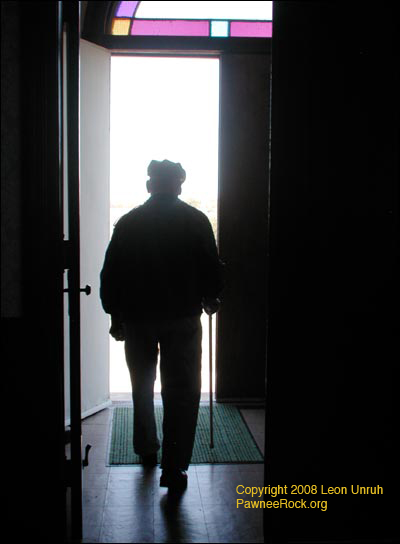
[February 17] Doorways are symbolic. Going through one is a passage to a new life, a new job, and so forth. But sometimes a doorway is just a doorway. This one is in St. Paul's Lutheran Church at the Barton County Historical Museum in Great Bend. And when you go out through this door, what you'll find is bright sunshine and wind. Most of the photo has starkly black and white areas, but I enjoy the subtle tones in the floor and window. And maybe I would like to read a little symbolism into the image as well. LaVerne Unruh dies[February 15] LaVerne Unruh, a longtime Larned resident who was born in Pawnee Rock in 1919 and married Lois Unruh in town in 1941, has died in Newton. He was a member of the Mennonite Church, and his burial will be in the church cemetery north of Pawnee Rock on Saturday. (Obituary on February 14) Sewer problems? Call your senator[February 15] Do you have sewer problems? I have just the guy for you to call: Senator Sam Brownback, Republican from Kansas. I was browsing this week through the database of congressional earmarks (compiled by Taxpayers for Common Sense) in search of money directed toward Pawnee Rock -- and found nothing. But I did see that Senator Brownback directed $492,000 to Larned for a sewage plant and another $492,000 to Great Bend for sewer repairs on 10th Street. This wasn't all Senator Brownback's hard work. Representative Jerry Moran was his partner in the Larned deal. The money came out of the Department of Interior budget. You can find all the details at taxpayer.net. Download the earmark database; it's a 3.9 MB Excel file and will take a moment, but you'll find information about every senator's and representative's effort to buy his or her way into your heart. Trees are out of place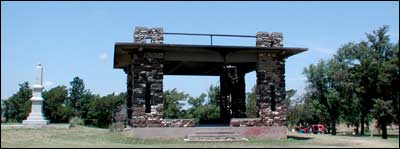
[February 14] Larry Smith, who lives in Wichita but grew up in Pawnee Rock, adds to our discussion of the trees on Pawnee Rock. Here's what he wrote Wednesday: "I read your column with interest and here is my rebuttal. Dutch elm disease and ice storms have shown that the elm tree is not native or a good choice. Cedar trees are useful in shelter belts (which are disappearing) but not only are they not native, they are a detriment to the prairie. They suck up a lot of moisture and change the wildlife habitat. It has been shown that quail populations suffer from the infestation of cedar trees and other animals are impacted. "If all the trees were removed (but the picnic pavilion left), the sense of openness and the reach of the prairie would be more accurately reflected. "If the wind seemed harsher because of the lack of a wind break . . . well . . . it did not stop the pioneers from settling there and would be . . . Kansas." Larry makes some good points, and it made me think of what I like about certain other "wild" parks in Kansas, specifically at Wilson and Kanopolis reservoirs and Monument Rocks. It's the openness, the grasses, the 360-degree view, and the wind. It's knowing that the Kansas I'm seeing is like the Kansas the pioneers saw -- the Kansas my own ancestors saw. Walter Stueckemann, our lawyer[February 14] Bill Stueckemann of Hutchinson saw my mention of Walter Stueckemann's obituary. I had wondered whether the just-departed lawyer was one of the two who sued on behalf of Pawnee Rock's effort to keep its high school in 1971 and '72. Bill wrote: "Yes, Leon that second lawyer was my Dad, Walter. I remember his talking about the case. Thanks for thinking of Dad." Bill, we're grateful for your dad's work. Wrong parks department[February 13] The Department of Wildlife and Parks points out correctly that Pawnee Rock doesn't fall under its jurisdiction. "The locals may put a sign up calling it a state park, but it is not," wrote Mark Shoup. Actually, the park belongs to the Kansas State Historical Society. I knew that (it's a state law), but in my haste yesterday my mind blitzed right over that fact, which of course is the same as not knowing it at all. So I have written instead to the KSHS to find out the information I had asked the parks department. I'll print the answer when it comes. Let the branches fall where they may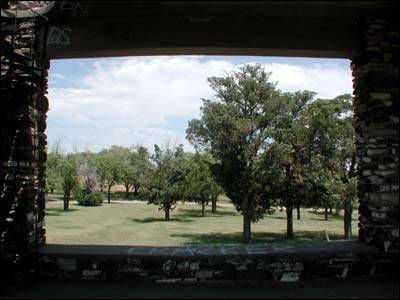
Through which historical frame should we consider the trees in Pawnee Rock State Park? (The photos below of the old gate to the park and of the Model Ts lined up at the 1912 park dedication were provided by Larry Smith. More park photos are available in the Gallery's many pages.)
Cheryl Unruh wrote: "Doesn't look like anyone has made any attempts to clean it up. Surely the state of Kansas would pay (not that they have any money.) Who has the everyday responsibility at the Rock -- the Lions Club still?"
Who does have cleanup duty at the Rock? Is picking up the branches a matter of money? In search of those answers, I sent an e-mail to the Kansas Department of Wildlife and Parks. I'll let you know what the official answer is, and perhaps someone locally knows the real-life answer. Larry's suggestion that the elms and cedars don't belong on the Rock at all raises a bigger question of whether the trees should be removed so that the park will look closer to the way it did -- a windswept hump -- before the Pawnees and other tribes were pushed away. Granted, the south and east sides of the park -- where the sandstone bluff is -- also don't look much like they did in 1872. The Rock's early owners quarried much of the bluff for use as railroad track ballast and building material.
Zieber provided the elms that once lined the road to the Rock. The arrangement of trees on the north side brings to mind the idea that while only God can make a tree, only a man with a contract will plant them in such straight rows. Now, I like the loosely spaced trees. They provide a shady public haven, which is a rare thing now that most of the streetside trees in town have been taken out. As I drive southwest on U.S. 56 from Great Bend, I enjoy seeing the line of leafy green once the Rock hauls into view; the trees, more than the cliff, indicate the presence of the landmark. The trees provide a sense of substance and elevation to what otherwise would be just another low hill with a broken side.
Those things did happen there, but no one cares. Everyone always looks to the south and east, where the elevation drops off dramatically and you can see the distant elevators and imagine the path of the trail. On the north side we picnic and, if we're of a mind, we can walk in solitude because nobody goes to the Rock to see the trees. Maybe our ancestors did, however, in the roaring days when the trees were as new as the picnic table and when glee clubs wore straw hats and mooned about June. The north side of the Rock even then would have been the best spot for romancers -- public but shielded from town. Like many people who grew up in Kansas, I'm reluctant to advocate the removal of trees. Except along the waterways, our trees are the fruit of human endeavor: Someone chose a sapling, dug a hole, and made sure the little gal had water. The trees grew up against the wind and shelter us from it, the cedars provide visual relief in the weary winter, and a stand of trees in a field often is all that says "people lived here." That brings us back to Larry's suggestion that the Rock should be returned as much as possible to its pre-1872 appearance, before people lived here. The Rock nowadays wouldn't be recognized by Kit Carson or the Pawnees. One change -- the pavilion, built in the 1920s -- does provide at least a sense of the elevation the Rock supposedly once sported, but everything else is different. Is what we have better than nature gave us?
Baldly put: Are the trees themselves an act of historical vandalism, put there to mark the conquering of territory? Or are they an improvement, joining the flourishing town to a landmark once known as the most feared spot on the Santa Fe Trail? In recent years, the further improvements -- a picnic shelter, toilets, a light, the driveway around the pavilion -- have been slowly beaten down by the climate, vandals, and stingy funding. Perhaps the question we, the children of Pawnee Rock, face is whether to speed the landmark's return to the days when the wind flew unhindered over the ancient bluff. If we do that, would we be recklessly casting aside the memory of our town's early leaders and the memories we all have of the trees, or would we instead be celebrating our landmark's true place in natural and national history? Details of the noodle dinner[February 12] Janice Schmidt wrote with more details of the March 1 noodle dinner at the depot in Pawnee Rock.
The menu will feature homemade egg noodles: chicken and noodles and beef and noodles. Diners will also get a veggie, cake, and coffee or tea. Janice mentioned the drawing, which will be held at 2 p.m. Prizes include a $50 gift card from Wal-Mart, $25 cash from the Lions Club, a fleece throw, two oil changes (Dee Dove and Becker Tires), plus three baskets of goodies, a wreath, and a surprise. Tickets are $1 per chance. Be there: Saturday, March 1, 11 a.m. to 2 p.m., at the depot on Centre Street. There's lots of free parking, and the depot is accessible for wheelchairs. If you're coming from out of town and need to walk off a few calories before hitting the road, you're welcome to stroll around town, visit the antique shops, or admire the view from atop Pawnee Rock. Storm damage on the Rock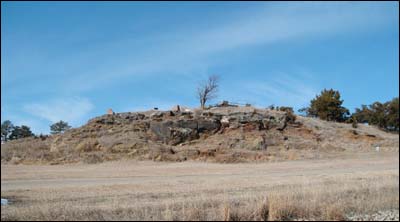
Pawnee Rock State Park, February 2008, by Larry Mix. The four following photos are also by Larry. 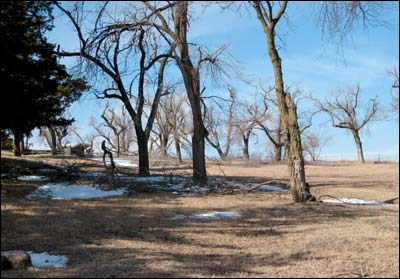 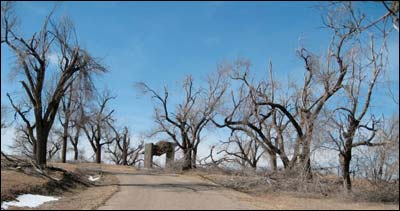 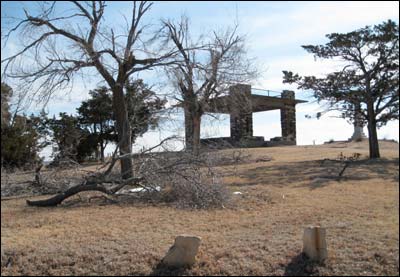 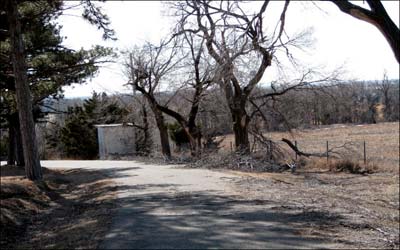
[February 12] Larry Mix of St. John and the Santa Fe Trail Research site drove through Pawnee Rock the other day and took some photos of how Mother Nature pruned the elms and cedars at the state park during last December's ice storm. Larry, a generous sharer of photos, sent a whole bunch. I couldn't use all of them on the homepage, so I'm displaying more of them here. Learning in the dirty world[February 11] I played on the edge of Santa Fe Avenue after many storms, those plains downpours in which a fortnight's worth of rain falls in 30 minutes. The shallow ditch in front of our house -- before the concrete curbs and gutters were installed -- ran brown and fast as the two blocks up the street drained, and a kid who moved quickly could have fun. Rock by small rock, I meticulously placed a solid base for a dam, then piled handfuls of sand on the rocks, starting from the grassy edge and working toward the street. Eventually, the dam would block the water and be big enough to handle the pressure of a much larger pool. I built dams. I watched them erode. With twigs, I picked them apart, and with thrown stones, I blasted them. Some grownups might call that a waste of time. But I don't look at a dam now without being interested in how it's built. When I see an impoundment, I think of how a stream brings dirty water into clear water and how the sediment piles up. Having seen ditch water fill a new lakebed, I have a better sense of what's below the surface, and because I built leaky dams I saw for myself how moving water and silt create alluvial fans. Because I watched water tumble my pebbles of quartz and granite, I realized how the Arkansas River valley could be filled with gravel washed down from the Rockies. All this was available because my parents let me play at the edge of the street and because I paid attention to what was right in front of me. Growing up in Pawnee Rock was a big advantage, granting me a heightened understanding of the physical world compared to my city-born and city-bred coworkers. I'm curious about things in ways they don't even think of, and farm kids no doubt put me to shame. City kids didn't have grass fires -- or even wood fires -- to play with. But we learned how to bank a fire and where to drizzle water to control the fire or put it out. The wind taught us things, and the grasses and trees taught us more. We took apart bicycles, lawnmowers, cars, and tractors because they were handy and we had tools, although not always the right ones. We know how valves work as the cylinder moves, because we've seen it happen. We swarmed like ants onto every pile of sand and dirt in town, riding bikes up and down it, tossing clods, and burrowing in up to our elbows. We learned about acceleration and braking, about angles of repose, and about heat and water absorption of various earthy materials. (And, in some cases, about property rights.) We know the life cycle of the grains and cattle; food production is not a mystery to us because we imitated our uncles and planted tiny patches of wheat or corn in our yards. We saw weather systems march across our township; meteorology is an extension of our distant-horizon curiosity and obsession with rainfall measured in the hundredths of an inch. We dug for clay in clefts of the limestone hills; we have a feel for sedimentary rocks and processes that a child who must learn only through books will never enjoy. We stood in the Arkansas River and knew from the beginning that it's more than a blue line on a map. We carry what we learned about sand and muck, currents and backwaters, channel cats and mosses to every other stream we ever explore or read about. I know things are different these days, what with stranger danger and video games and all that. Still, the opportunity exists in Pawnee Rock for kids and young adults -- even for grownups who allow themselves -- to go outdoors by themselves and learn by doing, by seeing, and by connecting the dots. Yes, you and I are grownups and have a million things to do, and the neighbors are watching. So what? Let 'em get their own sandpile, and you and I will play in ours. Lions to offer noodles March 1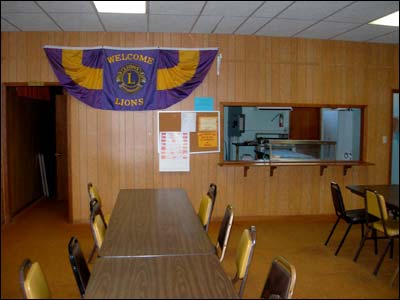
Inside the depot, where the noodles will be served.
The meal is from 11 a.m. to 2 p.m. The noodles will be homemade, or depotmade, on February 27. Janice Schmidt wrote, "We also have 9 good prizes for the drawing." They'll include a $50 gift card from Wal-Mart, $25 cash from the Lions Club, and oil changes. More details will be posted as they're available.
Tabitha Blair wrote: "The second girl from the left is Treva Russell and the last girl is her sister Reva Russell. Their father was the Christian Church Pastor and ran the Pawnee Rock youth group." "I believe the pic was taken around '88 or '89 and they would have been 6th or 7th grade." Treva and Reva, Tabitha would like you to e-mail her. Her address is PR-tabbyblair@hotmail.com (delete the "PR-" from the address first; it's there to fool the spambots). 20,000 GOP votes: The good Republicans of Kansas have cast their lot with Mike Huckabee of Arkansas, choosing him over John McCain of Arizona and Washington, D.C. Quite a few votes were also cast for also-rans Fred Thompson, Alan Keyes, and Ron Paul. It's heartening to see that Kansans, including Democrats, are coming out of their shell and picking candidates who aren't conventional. A photo I like: No. 73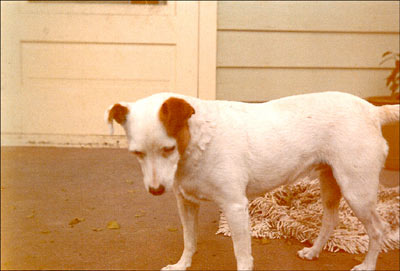
[February 9] This is Patches, the first dog that I really got to keep. She has been gone for quite a number of years and, I'm told, died in my sister's arms after I moved out. I have two dozen or so black-and-white photos and negatives of our little rat terrier-Chihuahua mix, but this is the only color version I could find. Patches was never of the pastel world, as this faded image is, but instead was a livewire of white hair and brown patches. She was as quick and yip-yippy as you might expect of a variety bred to chase rodents. I got our very first pup when I was around first or second grade; if I remember right, she came from the Givens family. Shortly after she gave birth to pups sired by the Brights' big dog, she snapped at a neighbor boy who was taunting her and was taken to the pound in Great Bend. My mom later said our dog was adopted out to a good family, and I lived for years mollified by that prospect. Patches was different. She was hardly big enough to fill a soup bowl when I got her from the Schraeders, who lived a block and a half west of us on Santa Fe, but she ran home to their house when we left her outside the first night. She turned into a loyal companion, however, following Cheryl and me around town and going out to the cemetery to help us maintain the grounds (and to chase ground squirrels, which was probably more of an attraction to her). Patches, who lived for I think 18 years, was the dog every kid should have. She was the right size and had the right attitude, and she always listened patiently to me. Like all dogs, she slept day and night, mostly under our living-room counter. On bright days she'd find the sunny spot on the living room floor, waking up to move over a linoleum block or two as the afternoon passed. It was sunlight that saved Patches' life when she was young. Cheryl and I had her in the back of Dad's pickup as he drove us to the cemetery, and she leaped out in excitement when the truck flushed meadowlarks from the ditch. A couple of weeks of greasy salve eased her torn skin, but she was a pretty sorry pooch with some damage inside. I suspect that we were all waiting for her to die, and I walked quietly around her as she slept under the counter. One afternoon the sunbeam found Patches and nudged some thermostat in her soul. I was in the room with her, and I swear an aura grew around her curled little body. She awoke. She stood slowly. She half-wagged her tail. And on that transcendent day, she tottered over to lick her boy. I don't think we ever let her ride loose in the pickup again. 130 years of Rock ownership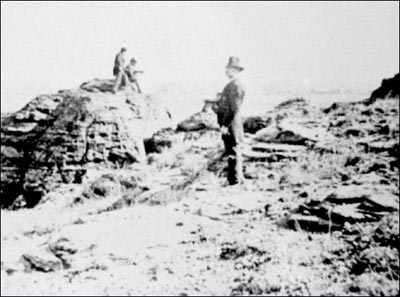
This view from the late 19th century shows a column of sandstone standing southeast of what we know as Pawnee Rock. [February 8] One hundred years ago, the landmark we know as Pawnee Rock was deeded to the state of Kansas by Benjamin P. Unruh. That's common knowledge, because that fact is carved into the monument atop the Rock.
Years after the U.S. government bought the plains from France in the 1803 Louisiana Purchase, the section of land holding the Rock and many others were handed to the Santa Fe Railroad to be sold or quarried to cover the costs of running the railroad across Kansas. When the railroad came through in 1872 and the town followed immediately, the AT&SF held the title. According to records published by Sheila Sutton Schmidt in "Pawnee Rock: A Brief History of the Rock," the changes in ownership occurred this way: Northeast Quarter of 33-20-15
In 1893 Mr. Roddy sold his two acres to Anna L. Parker. Mr. J.R. Baker bought Mrs. Parker's two acres and the rest of the quarter belonging to Mr. Bunting in 1898. In 1901 Rev. Benjamin P. Unruh bought from Mr. J.R. Baker the northeast quarter of 33-20-15, Pawnee Rock Township, Barton County, Kansas, on which The Rock stands. Athletes identified
The girls are, from left: Liz Smith, Jyl Behrens, Linda Spreier, and Brenda Smith. They're members of the Classes of '72 and '73. Walter Stueckemann: Remember back in 1972 when our town hired Ben Lightfoot and another lawyer to try to keep our high school open? Was that second lawyer's name Walter Stueckemann? Stueckemann, who died Sunday in Dodge City, was born in Great Bend. During the 1970s he was a lawyer in Jetmore, which is where Lightfoot also practiced. His obituary was in the Hutch News. What do you expect from politicians?[February 7] The good Democrats of Kansas have enunciated their desire for a president who has a different vision of leadership. It happens to be a guy with family connections to the Sunflower State. On Saturday, we'll see how the good Republicans vote. It's a cheerful thing when voters get aroused enough to turn out in large numbers (see Cheryl Unruh and Peg Britton). Let's hope the politicians don't waste our enthusiasm. Many years ago, during one my "stages" after a little bit of college education, I announced to my mom that I was a conservative. She was surprised. "It's our job to keep things from changing too quickly," I explained. Well, at least I recognized that change is inevitable, but I'm not so proud of myself for adding my soul to the brickpile blocking the highway. I've changed. Now I don't think I could vote for a candidate -- and I know this is the primary season, when candidates pander to the extreme wings of their parties -- whose campaign identity is built on the idea of being against more stuff than his opponent is, who says he wants more than anything to turn to the way things used to be for his part of the population. If the country has learned anything in the past seven soiled years, it should be that we don't need more plunderers, more impediments. We need builders. I don't mean just the White House, but us too. There's no shortage of people waving flags and Bibles in our faces while they try to pick our pockets, but let's put aside those distractions. We're all patriotic, and we each have the faith that suits us. What we need is an honest leader, one whose vision includes a better life for all of us. As the folks in Emporia will tell you, life is hard enough without having to live at the whim of people whose stock options become more valuable when you get less for your work. The laid-off people don't want "straight talk" from the suits; they want fairness. The working people of Pawnee Rock are just as vulnerable. Our life is changing, and it's going to change further in interesting ways. You and I can help direct that change, or we can clutter up the highway. What do you choose? Hello from Robert Schmidt[February 6] Robert Schmidt, son of former teachers Earl and Maxlyn and a member of the Pawnee Rock Class of 1969, wrote yesterday from Georgia, where he's living the good life. That's "good" in the sense of helping others. He's the director of Planned Giving for Habitat for Humanity International, which has its headquarters in Atlanta.
Robert asked to be listed among the Friends of Pawnee Rock, which he now is. Here's part of his note: "Among my memories are many enjoyable 4-H woodworking evenings in your Dad's shop. One event in particular stands out. Steve Unruh had cut a board too short and my dad and Olin Unruh, standing around the wood-burning stove, had a good laugh as Elgie sent Steve to look for the 'board stretcher' in a dark corner of the shop. "You mention Howard Converse. Was he the spouse of Eloise, from whom I took piano lessons? There's an interesting story in the Converse family you might want to track down. Apparently someone in the extended family was very interested in watermelons and experimented with developing new strains. My mother told of evenings when the community would be invited for all the watermelon one could eat. "The only stipulation was that the seeds be sorted and kept for further experimentation. I guess we had our own Gregor Mendel in PR." Does anyone else remember the Converses' watermelon experiment or feeds? In the back of my head is a memory of gathering at someone's farm where watermelons were cooling in a stock tank, but I have no idea whose farm.
It flatters me to be thought of in the same sentence as Cather, but ever since I read "My Antonia" many years ago I have without fail thought of her spare writing when I stand at the edge of a pasture and raise my hand against the sun. By and large, her sense of hard work and the romance of open country influences the way I see our township. Howard Converse dies[February 5] Howard Converse, 95, died Saturday in Great Bend. Howard belonged to the Methodist Church of Pawnee Rock, the Farm Bureau and the Radium Co-Op Board. His survivors include two daughters, Betty Karen Converse and Barbara Jo Converse Stevens. His wife, Eloise, died 15 years ago. His funeral will be Wednesday at Beckwith in Larned, and he'll be buried in Larned. The Converses lived a mile east and about a mile south of the Pawnee Rock Bridge. (Obituary on February 5.) There's snow place like home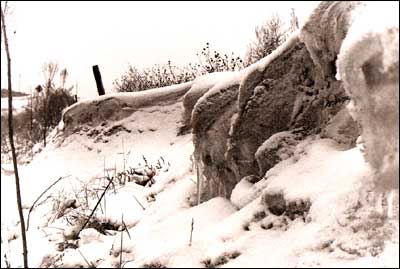
[February 5] Just as it can't possibly be true that two snowflakes are alike, it must be true that snow has fallen straight down on Pawnee Rock. But if it did, I wasn't there that day. Snowfall for me was whispy whitish waves, pushed by the wind, that sashayed down the highway in front of my car. It was miniature drifts creeping into the road from clumps of grass on the windward side of the asphalt. It was a ditch half full of snow, with an cornice where the wind had drifted a roof of sorts over the ditch. It was the stuff blowing directly in my face as I rode my bike to school. It was one drift as high as the back of the school, and a waist-deep drift across the driveway at my Unruh grandparents' farm. South of the river, it was the furrows in a frozen field still visible after a day of snow. It was flakes whipping over the top of our house and down my coat while I, on the south side, shoveled our sidewalk. No, our snow didn't come down like it does on Christmas cards and in cheesey movies. It all fell somewhere else and was blown sideways across Barton County. Super Tuesday: It wouldn't be right to ignore Super Tuesday, now that Kansas is a part of it. I have to wonder, however, why Pawnee Rock's Democrats (or Democrat, as the case may be) are encouraged by the state party to drive all the way to Pratt for their caucus. Did the Republicans arrange that for their opponents? Or was Pratt the closest town in central Kansas where you could find two Democrats to rub together? The local Republicans, meeting Saturday at the Highland Hotel in Great Bend, seem a little more organized. Keith Davidson: Keith Davidson, 75, who many of us knew as the father of our schoolmates Crystal (Schmidt), Julie (Scott), Melinda (Hammond), as well as Brock, died Sunday in Larned. His wife, Ardith, survives. (Obituary) Ralph Gillispie writes from Idaho[February 4] Ralph Gillispie knows Pawnee Rock from way back -- he was a grade-schooler here in the mid-1930s before his family moved to Larned. Now Ralph lives in Burley, Idaho. He wrote an information-filled note and later sent along the photo of Ira W. Cheney, the blacksmith who whose photo is now in the Gallery. He lived in town for a couple of years and obviously kept his eyes and ears wide open. Here's Ralph: "I am pleased to have found your website . . . brings back many great memories of the people in the photos, and times spent hiding and playing 'cowboys and Indians' among the rock formations on The Pawnee Rock as well as many a summer night spent listening to the townspeople playing fiddle, guitar, banjo et al., and dancing till late on the pavilion. "My name is Ralph Gillispie and my connection to Pawnee Rock is way back in time to mid summer (July-August) of 1935 through June-July of 1937. "Although I was only in the first and second grades there, under the educational training and watchful eye of the lovely Ms. Franklin, I consider those years to be the most memorable. Rembering the good times and days is a favorite pastime as we grow 'older.' "Among the many wonderful pictures on the site I found a few that stand out in my memory.
"Billy Joe, Terry Keeley, Bob and Billy Wycoff and I spent many an hour on our knees around a circle of Marbles! Although, at that age we were not really good at the game . . . haha! "I recall one time I decided to go spend the day with Terry at his farm. Being a 'big boy,' I conveniently forgot to let my parents know of this decision. Terry and I were in the hayloft of his family barn and were afraid to come down because one of their bulls had decided to come in and eat. We sat up there till after dark and finally got our courage up to come down and make a run for it! Needless to say, when I finally made it back home, my father and his leather belt were there to greet me! "Ahhhhh, yes . . . memories!!
"My grandfather is buried in the Cemetery at the Rock. "I spent a day touring Pawnee Rock back in February of 1998. Looked for the old school, did not know at the time that it had been long gone from its position. "I did find the house that we lived in on Santa Fe, just a block off the main street, South side of the street. The back of the house is in a couple of the pictures. "My sister is June Elene Gillispie (Rogers now), and she was in the fourth and fifth grades during those years. She recalls the names Vera and Vena Wycoff, as well as the Dixon family that lived there at the time. "Our family moved from Pawnee Rock, back to Larned in '37. "Some other names that are very familiar are Donna Jean Carpenter, Elmeleda Mae Houser, Schultz dairy, and I believe I still have one of the old D.R. Logan tokens! I may also have an old photo or so. If so, I will be happy to upload them to you. "Anyway, thank you for your care and diligence in putting up this great website! In the past two days since I found it, I have spent at least 10 hours going over the information and pictures." About the familyI asked Ralph to tell me more about his grandfather. "My Grandfather's name was Ira Webster Cheney, he was known as The Whistling Blacksmith . . . he owned the blacksmith shop in Dundee circa 1915 . . . purchased it from Kern and Mead. I am still trying to find out just when he moved into Pawnee Rock. He and a Mr. Sanford Charles Hill of Pawnee Rock died the same day, Sept. 4th, 1935, and both are interred at the Cemetery. I have the original Obituary from the Great Bend Tribune for both of them. "My parents were Mr. Charles Irvin Gillispie and Mrs. Mildred Mary (Cheney) Gillispie. My father was trying to do a little startup business when we moved into Pawnee Rock. He contracted to do laundry pick up and delivery for the Ideal Laundry in Larned. His route would take in Dundee, Pawnee Rock, parts of Larned, and Kinsley. He drove a new (1934) bright red panel Ford truck, as I recall. The business did not go well for several reasons, and he ended up working for Ideal as a night watchman/laundry man from 1937 to 1942. "The Unruh name is quite familiar also, being friends with my Uncle Bill Cheney and Aunt Josephine, as I recall. "Does anyone have knowledge of Terry Keeley, Donna Jean Carpenter, Elmeleda Mae Houser . . . just a couple names that I have never forgotten over the years . . . and of course, Ms. Franklin . . . where they are, alive, etc.? "My very tentative and tenuous plans (if you can call them that) are to visit Pawnee Rock later this year, probably mid summer, if I can swing all the details into place." Ralph would like to hear from you. I've added his name to the Friends of Pawnee Rock. I was Len Dawson[February 3] I was Len Dawson, and then I was Otis Taylor. Sometimes I was E.J. Holub or Buck Buchanan or Mike Garrett. I was a Kansas City Chief, tossing my orangish football up in the air and running ahead to catch it in the slanting October light, then swiveling my hips and sprinting to the edge of the driveway as the fans in the shrubbery cheered. It was the late 1960s. I wasn't even in junior high yet, and so I had no idea of what organized football was all about. My football games occurred in my front yard, by myself or with my sister, or over in one of the yards next to the Brights' home, where a game was always going on. Like a lot of kids at the time, I had been introduced to pro football through black and white television. I read a lot of kids' books about football, although they were all written for eleven-man teams and used plays that nobody talked about anymore. Later, when our family drove to Indiana to pick up a new school bus, I took along one of those magazines that has player profiles and statistics and I think I memorized it over the three or four days it took to get to Fort Wayne. When the first Super Bowl happened the following January, I was ready. Our Chiefs played Green Bay and lost (which wasn't as bad as any game when they lost to the despised Oakland Raiders). But three years later in 1970, when the Chiefs next played in the Super Bowl, they beat Minnesota. Over the decades, the Super Bowl magic has worn thin for me. Being one of the cooks in the media kitchen has dulled my appetite for the endless dross leading up to the game, and now I get hopped up only when the Cowboys get in or when the Chiefs make a run at the playoffs. I fear that football, like many of the joys of simple childhood in Pawnee Rock, has gotten out of hand and become just the business of football. Maybe for kids there's still pleasure in it. I played one meager year of junior high football before the Chiefs won the Super Bowl, and my gridiron dreams were fairly well humbled during that season. My soul, however, is not dead. Even though it turned out that I'd never be Len Dawson or Otis Taylor, I can sit before the television on a midwinter day and remember the October afternoons when I caught my own towering passes and the fans cheered. A photo I like: No. 72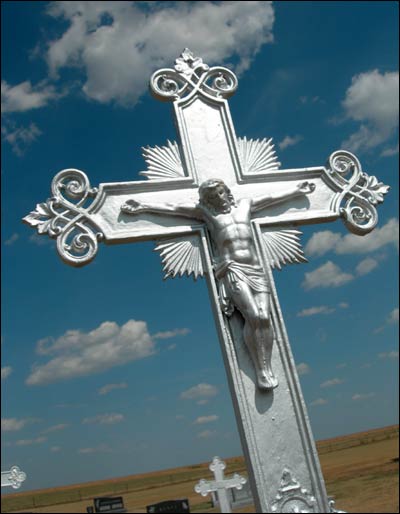
[February 2] The Sacred Heart Catholic Church's small cemetery at Park, along I-70 in northwestern Kansas, stands out among many I have visited during the past decades. The steel crosses are painted for longevity, I suppose, but the choice of silver paint had another virtue. I would love to visit the cemetery late on a summer evening, when the crosses would catch the last light and glow against the deepening sky, or when the sun pierces an overcast sky. At that moment, I think, I would be able to feel the Ascension. Park never was very large; it's the kind of place where streets turn into field driveways at the edge of town. Although one might think the town itself is going to return to dust before long, the cemetery is cared for like it's going to be needed for another century. Prairie Dog Day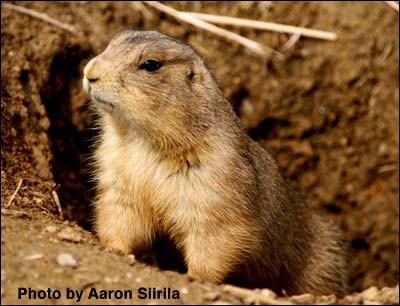
[February 1] It is on February 1 that we remember Pawnee Rock's history with the prairie dog.
As you know, when our ancestors came to Pawnee Rock in the early 1870s they often had little to eat, because it took a long time for crops to grow -- and when the crops did grow, the prairie dogs often crept in from the edge of town and stole the potatoes and carrots right out of the ground. Such pests! The angry new Pawnee Rockers tried to shoot them all. Then came the grasshopper plague of 1874, when swarms devoured almost all of the rangeland grass and the vegetables not taken by the prairie dogs. Food animals like deer moved away to places south of the Arkansas River where they could find grass. It was Pawnee Rock's most desperate hour. The following winter was miserable, what with the hunger and the snow and the biting wind and the lack of trees to provide fuel for the stoves. Families huddled in their unpainted, drafty houses, scooting ever closer to stoves burning dried bison patties. The future was grim. Starvation was upon the land. But early on the morning of February 1, 1875, things changed. A young boy named Josiah Caswell was leaving his family's home to look for chunks of coal that had fallen from the passing trains. He backed out the door, closing the latch softly so as not to awaken his little brothers and sisters, and stumbled over potatoes and carrots piled on his icy doorstep. A miracle had happened! His joyful hollering woke his family and the neighbors, and they came running. Some tried to grab the food right away, but Josiah's mother divided the food among all the families. Josiah's father spotted little footprints leading from their home off into the fields, and Josiah and his dad followed the tracks south a short distance until they came to the prairie dog town. It seems that the little rodents, who had so energetically harvested vegetables from the Caswells' garden all summer, had taken more than they could eat. Being good stewards of their pantry, they apparently dragged some of the leftover food back to the Caswells' house so the family wouldn't starve. After that, no Pawnee Rocker ever shot a prairie dog. In fact, each autumn the families set aside extra root vegetables to make sure the prairie dogs didn't go hungry during the lean months. And, as humans do, they adapted a tradition they already had -- the Christmas stocking -- to Prairie Dog Day, as they came to call February 1. Shortly after sunset on the evening of January 31, the grownups of Pawnee Rock would slip out to the prairie dog town and drop a small toy, identified with their child's name, into one of the many holes. When the children awoke the next day, they pulled on their tattered coats and ran gleefully to search for the special hole with their present. Oh, the laughter! Now, some doubters say there's no truth to this, but I'd like to believe that the prairie dogs were very wise. They wanted to keep the Caswells and their neighbors from leaving so that there would always be a garden to plunder. And that, my friends, is the true meaning of Prairie Dog Day. Over the years, especially after the horror of World War I, people in Pawnee Rock lost faith in the Prairie Dog Day tradition. But it's worse elsewhere. We know that many ranchers kill prairie dogs, claiming that Cynomus ludovicianus carries plague-infested fleas or that whole cattle tumble into prairie dog holes. And yet the greatest sadness of all -- I'm weeping as I write this -- is in Oakley, where idolators have molded a 17-foot prairie dog and a smaller pup. They induce pilgrims in search of a blessing to pay a small fee to stand beside this statue in order to have a graven image produced. Let us not fall into that trap! We can only hope that we regain our innocent faith in Prairie Dog Day before the next grasshopper plague besets our fair land and a small child cries with hunger. |
Sell itAdvertise here to an audience that's already interested in Pawnee Rock: Or tell someone happy birthday. Advertise on PawneeRock.org. |
|
|
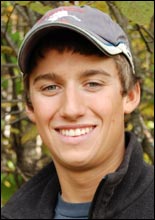 Jeff, with about a hundred other mushers, is leaving the Alaska highway system at Willow, north of Anchorage, and heading across frozen lakes and rivers, spruce and birch forest, rough tundra, and mountain passes. He'll be watching for moose on the trail and icy spots that could upset his applecart.
Jeff, with about a hundred other mushers, is leaving the Alaska highway system at Willow, north of Anchorage, and heading across frozen lakes and rivers, spruce and birch forest, rough tundra, and mountain passes. He'll be watching for moose on the trail and icy spots that could upset his applecart.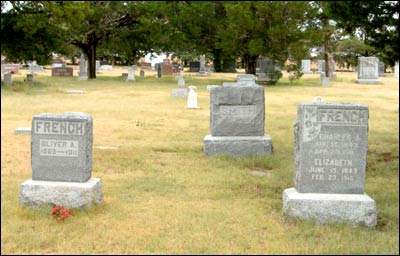
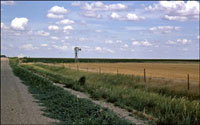

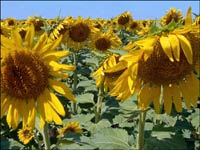
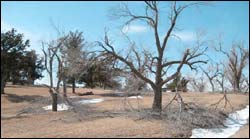 [February 13] Larry Mix's photos of two-month-old
[February 13] Larry Mix's photos of two-month-old 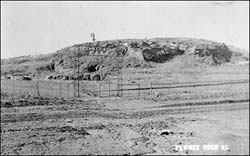 Larry Smith wrote: "The damaged trees on the Rock seem like a perfect opportunity to get rid of something that should not have been there in the first place."
Larry Smith wrote: "The damaged trees on the Rock seem like a perfect opportunity to get rid of something that should not have been there in the first place."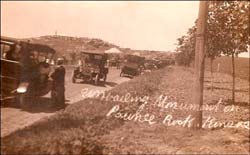 Settlers being settlers, they looked at the Rock first as something to take apart for their own use and then as something to remodel in the fashion of what they considered a true park. The 1908 contract with Benjamin P. Unruh for the donation of the land required the state to spend $3,000 for a road and other improvements, and it wouldn't be surprising if some largesse for local nurseryman
Settlers being settlers, they looked at the Rock first as something to take apart for their own use and then as something to remodel in the fashion of what they considered a true park. The 1908 contract with Benjamin P. Unruh for the donation of the land required the state to spend $3,000 for a road and other improvements, and it wouldn't be surprising if some largesse for local nurseryman 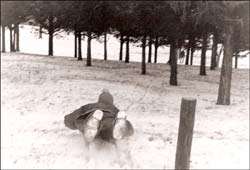 I have climbed on the Rock since I was a toddler, yet I wonder now what I've missed. I'm like you: I've sat up there and pondered the world. I've sledded there, and drawn pictures and blown up anthills there. I've drank beer and peed against the rocks there. I've kissed there. (It would be naive to think that our grandparents and the wagoneers and the Pawnees before them didn't do the same.) But because the trees blocked my view back in time, I've never been able to understand the north side of the Rock as "real," as a short-grass plain where soldiers and tribesmen camped and buffalo grazed.
I have climbed on the Rock since I was a toddler, yet I wonder now what I've missed. I'm like you: I've sat up there and pondered the world. I've sledded there, and drawn pictures and blown up anthills there. I've drank beer and peed against the rocks there. I've kissed there. (It would be naive to think that our grandparents and the wagoneers and the Pawnees before them didn't do the same.) But because the trees blocked my view back in time, I've never been able to understand the north side of the Rock as "real," as a short-grass plain where soldiers and tribesmen camped and buffalo grazed.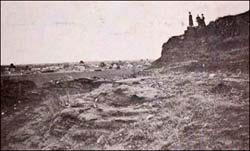 Although Pawnee Rock State Park has been institutionalized as a monument to the Santa Fe Trail, the "improved" Rock is more a monument to the will of townspeople and farmers to subjugate every acre within reach. The park wasn't set aside just to protect the historical significance of the landscape at the behest of outsiders, but also to codify what was a fact of life: People wanted to stand on top of the Rock, and that led to the business of making it more hospitable for adventurers.
Although Pawnee Rock State Park has been institutionalized as a monument to the Santa Fe Trail, the "improved" Rock is more a monument to the will of townspeople and farmers to subjugate every acre within reach. The park wasn't set aside just to protect the historical significance of the landscape at the behest of outsiders, but also to codify what was a fact of life: People wanted to stand on top of the Rock, and that led to the business of making it more hospitable for adventurers.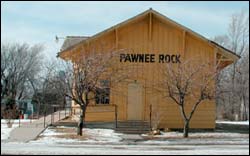 The meal, served from 11 a.m. to 2 p.m., will be a fundraiser for the Lions Club, which owns and maintains the town's historic depot. The price of the meal is $6, and kids under 4 eat free.
The meal, served from 11 a.m. to 2 p.m., will be a fundraiser for the Lions Club, which owns and maintains the town's historic depot. The price of the meal is $6, and kids under 4 eat free.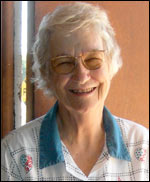 [February 10] The Lions Club of Pawnee Rock has scheduled its noodle meal for Saturday, March 1, at the depot.
[February 10] The Lions Club of Pawnee Rock has scheduled its noodle meal for Saturday, March 1, at the depot.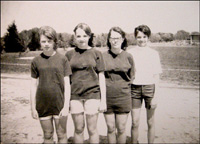
 But Unruh wasn't the original white owner of the big sandstone outcrop.
But Unruh wasn't the original white owner of the big sandstone outcrop.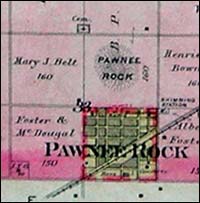 In 1878 Aaron Gaberick bought the northeast quarter of 33-20-15 in Pawnee Rock Township, Barton County, Kanss, from the Atchison, Topeka and Santa Fe Railroad. Times were hard. In 1887 he sold two acres to Michael Roddy. From the legal description we assume the two acres must have been The Rock. Mr. Roddy may have wanted stone for building purposes, or, perhaps, for a stone quarry business. Times continued to be hard for Mr. Gaberick. He mortgaged the quarter a number of times. Finally it was sold at a sheriff sale to Mr. Bunting in 1891.
In 1878 Aaron Gaberick bought the northeast quarter of 33-20-15 in Pawnee Rock Township, Barton County, Kanss, from the Atchison, Topeka and Santa Fe Railroad. Times were hard. In 1887 he sold two acres to Michael Roddy. From the legal description we assume the two acres must have been The Rock. Mr. Roddy may have wanted stone for building purposes, or, perhaps, for a stone quarry business. Times continued to be hard for Mr. Gaberick. He mortgaged the quarter a number of times. Finally it was sold at a sheriff sale to Mr. Bunting in 1891.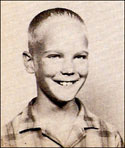 You knew Earl and Maxlyn would raise good kids, didn't you. (The photo is from his sixth-grade year.)
You knew Earl and Maxlyn would raise good kids, didn't you. (The photo is from his sixth-grade year.)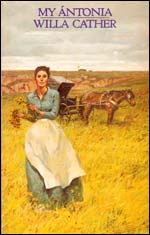 I should point out also that Robert is my friend for life because he compared the writing and photography -- yours and mine -- in Too Long in the Wind to the work of one of his favorite authors,
I should point out also that Robert is my friend for life because he compared the writing and photography -- yours and mine -- in Too Long in the Wind to the work of one of his favorite authors, 